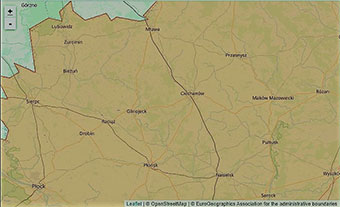The project involves the construction of a 71.21 km section of Poland’s S7 expressway between Napierki and Płońsk in the north of the Mazowieckie region. It will be located within the core Baltic-Adriatic corridor of the Trans-European transport network (TEN-T) and will form part of European route E77.
New section of Poland’s S7 expressway to strengthen transport links
- 06 November 2019
Objectives include creating a safe, comfortable, high-capacity section of road for long-distance, high-speed transit traffic that will have the capacity to handle projected future vehicle flows. The project aims to help reduce travel times and improve living conditions in local communities by channelling traffic away from urban areas.
Junctions with existing roads
The road will have two 3.5 m-wide lanes, a 2.5 m-wide hard shoulder and a soft shoulder of 0.75 m in width on both sides of a 12 m dividing strip. , as well as the possibility of adding a third lane. The planned maximum speed is 100 km/h.
Running partly along a section of the existing national road 7 (DK7) and partly along a new corridor mainly to the east of DK7, the road will include nine junctions: Mława Północ, Mława Południe, Modła, Żurominek, Strzegowo Północ, Strzegowo Południe, Glinojeck, Pieńki Rzewińskie and Dłużniewo. Sections of other intersecting roads may be built or rebuilt to adapt the existing network to the path of the S7. Buildings and structures blocking its path will be demolished.
Four rest and service areas – Długiewo, Ćwiklinek, Pepłowo I and Pepłowo II – will be built, as will necessary engineering structures. A road maintenance centre will be established at Glinojeck; sections of DK7 totalling 37.38 km in length will be adapted to function as local roads; the bridge over the river Wkra in Strzegowo will be repaired; and an intelligent traffic management system will be installed.
Further work involves construction of slip roads, pedestrian and bicycle lanes, emergency crossings, passages and mesh fences for animals (including passages linked to bridges, crossings and culverts), acoustic screens and road lighting, and landscaping. Safety equipment such as energy-absorbing barriers, anti-glare shields, fences and horizontal and vertical signage will be set up.
Storm water drainage, and pre-cleaning devices for rainwater flowing from the road into collectors such as watercourses or storm water reservoirs will be put in place. Utility infrastructure including gas and water pipes, sewage systems and telecommunications and power lines will be laid or re-laid.
Four sub-sections
The work is divided into four parts covering adjacent stretches of the S7: Napierki-Mława from km 0 to km 13.96, Mława-Strzegowo from km 13.96 to km 35.47, Strzegowo-Pieńki from km 35.47 to km 57.46 and Pieńki-Płońsk from km 57.46 to km 71.21.
Beginning near the Napierki junction, the section runs through the municipalities of Wieczfnia Kościelna, Mława, Szydłowo, Wiśniewo, Strzegowo, Glinojeck, Baboszewo, Stupsk and Płońsk, and ends at the Ciechanów junction, at the start of the Płońsk ring road.
The project aims to improve the quality of transport links in Poland through integration of the planned route with the rest of the road network, and to increase accessibility to – and strengthen interregional connections within – the TEN-T network.
In addition, by enhancing the efficiency of road transport, the project is expected to support free movement of people, goods, capital and services, thereby contributing to the EU's external competitiveness and internal economic, social and territorial cohesion.
Total investment and EU funding
Total investment for the project “Construction of the S7 expressway Olsztynek-Płońsk, section Napierki-Płońsk” is EUR 449 823 677, with the EU’s Cohesion Fund contributing EUR 242 459 568 through the “Infrastructure and Environment” Operational Programme for the 2014-2020 programming period. The investment falls under the priority “Transport infrastructure”.

